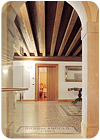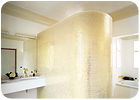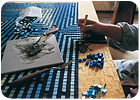
The original Orsoni foundry was established in the neighborhood of Cannaregio in Venice, Italy, in 1888. Housed in a structure comprised of brick and stone, the company is still in operation today, and an array of mosaic glass products are still hand produced at the factory on a daily basis. Dedicated to the production of Venetian glass smalti and gold leaf mosaic, the foundry was purchased by Trend Group S.p.A. of Vincenza, Italy, in 2003. The Orsoni compound itself has since grown to include a total area of approximately 10,000 square feet, comprising the original foundry and color library, as well as Domus Orsoni, which contains a five-bedroom bed and breakfast inn, office spaces and a mosaic gallery. The history behind Orsoni is a unique story of an art craft that has handed down mysterious alchemies for four generations, and it has revived the old crafts of Byzantine gold leaf mosaic and the pure smalti of Murano's Renaissance. Although there isn’t any specific detailed information about the original foundry, it is commonly described as a typical 19th Century Venetian villa. Built by a well-off family, the building is constructed of brick and Istrian stone, a white stone similar to marble, which is a common material used in Venice.

Renovation work
Renovated in 2000 from what was originally the Orsoni family villa, Domus Orsoni, a five-bedroom bed and breakfast inn, also contains the Angelo Orsoni Mosaic Gallery and the mosaic studio where “Master in Mosaic” classes are taught. Domus Orsoni is open year round to the public, and foundry tours are available by appointment. Many of the building features are original to the design, including the terrazzo floor, which was installed in 1903, as well as the architrave, the floor plan, the pergola and the stone parts. The Domus was a private residence until 1980, and the entire restoration, completed by architect Bruno Venturini and his son, Andrea Venturini, included the transformation of the family home into a commercial space, including offices and a mosaic gallery. In 2003, architects Carla Baratelli and Fabio Rotella, along with artists Lucio Orsoni and Marco Nereo Rotelli, designed the five bedrooms at Domus Orsoni, capturing the prestige and elegance of an authentic Venetian environment. Lucio Orsoni, great grandson of founder Angleo, and his partner, Pino Bizassa, supervised the renovation of the 19th Century ancestral villa within the protective walls of the compound to create Domus Orsoni.The surfaces inside the bed and breakfast inn intend to “mirror the glow of an incandescent furnace fire, the luminous pigments of the used crucibles and the charm of the romantic garden.” The original terrazzo floor and neo-classical furnishings are juxtaposed with literary and evocative mosaic-designed headboards and nightstands.“It has been a great emotion to create the bathrooms in their different characteristics, using wood and gold and other materials, melting them with mosaic tiles,” said Lucio Orsoni. One bathroom inside the bed and breakfast establishment features white and 24k gold mosaic tiles. Furthermore, the shower was designed with waves of smalti and 24k gold mosaics intended to recall the Adriatic Sea, which feeds the Venetian Lagoon. For another bathroom, Orsoni created a window to the outside world, where he placed a woman in mosaic ensconced against a field of black mosaic tile. “She is caught in a particular moment of freedom,” said Orsoni, adding that for this element, the designer used 24k gold turquoise mosaic glass against opaque glass to create a three-dimensional effect.
Taking inspiration from the Cave Michelangelo in Carrara, where he created a large installation called “Cave of Poets,” Marco Nereo Rotelli designed what is referred to as the Oro Turchese bedroom. For Domus Orsoni, Rotelli remembered the lines from Ruskin’s “Stone of Venice,” and wanted to use “a little room to contain big words.” He feels it is a little room that can lead to splendor and dreams of love.

Current Production
With respect for the authentic and symbolic value of mosaic tradition, Orsoni continues to use traditional techniques, with a single exception - the old coal furnaces have been replaced by gas-fired furnaces, allowing a purer, cleaner glass paste to be obtained. The roller used for smoothing out the glass paste is the model invented by Lucio’s great-grandfather, Angelo, and the old machines for cutting tesserae are worked on by women who turn small wheels that resemble those on older sewing machines, Orsoni explained. “Manufacturing today is supported from technology - mainly the energy to fuel the fire - which didn’t exist in 1888, but the method of production is manual and based on experience as in the past,” said Orsoni.Every day, hundreds of colored enamels leave the old factory in Cannaregio, decorating works of art, private spaces and public settings all over the world. “In the old Palazzo, the upkeep of the buildings and of the surfaces needs a particular attention and respect, and the avoidance of aggressive detergents,” said Orsoni.
Domus Orsoni provides the opportunity for guests to experience an historical setting that houses the alchemy of smalti production, the legacy of the influential Orsoni family and the gallery of mosaic art representing 200 years of masterful creation. Furthermore, guests can participate in the “Master in Mosaics” course, offered for one-and two-week durations during alternate months. “Living the Venice Workshop” offers private instruction by Maestro Lucio Orsoni and his protégé Antonella Gallenda. The course teaches technique, theory and application of mosaic art within the walls of an Italian bottega, and has recently been accredited by IIDA for 3.2 Continuing Education Units.
The Orsoni name is linked to such projects as the Trocadero and the Basilica of the Sacre Coeur in Paris, Saint Paul’s Cathedral in London, the Sagrada Familia in Barcelona, and many other mosaic masterpieces in Arab and Oriental cultures.
